Mahoberberis × Mahoberberis aquisargentii

ABOUT
× Mahoberberis aquisargentii, commonly known as the Oregon grape, is a hybrid ornamental plant that exhibits characteristics of both parents from which it was bred. The appearance of this plant is notable for its leathery, spiny-toothed leaves that resemble those of holly. These leaves often appear in a lush, deep green color, which may turn to shades of red and purple, providing seasonal interest and adding to the ornamental value of the plant. The Oregon grape is also admired for its small, yellow flowers that bloom in clusters, creating a striking contrast against the dark foliage. These flowers, which typically appear in early spring, give way to berries later in the season. The berries are initially a shiny green, evolving to a deep blue to blue-black color when ripe, often with a powdery bloom. These berries add to the visual appeal of the plant and can attract birds and other wildlife. Overall, the plant presents itself as a compact and bushy evergreen, offering year-round interest in the garden through its changing leaf colors, attractive flowers, and eye-catching berries. It is valued in landscaping for its adaptability and the multi-seasonal display it provides, serving as a versatile and attractive addition to various garden settings.
About this plant
 Names
NamesFamily
Berberidaceae
Synonyms
Mahonia Aquifolium × Berberis Julianae Hybrid
Common names
× Mahoberberis aquisargentii.
 Toxicity
ToxicityTo humans
As of my last update in early 2023, detailed information on the toxicity of × Mahoberberis aquisargentii, commonly known as Mahoberberis, to humans is not readily available. This plant is a hybrid and there may not be extensive data on its specific effects if ingested or otherwise contacted by humans. It is always prudent to treat unknown plants with caution and keep them out of reach of children and pets, as many plants can have toxic properties. If any part of a plant believed to be toxic is ingested, it is important to seek medical attention immediately.
To pets
Detailed information specifically addressing the toxicity of × Mahoberberis aquisargentii, known as Mahoberberis, to pets is lacking as of the most current information available up to early 2023. Without specific data, it is recommended to err on the side of caution and assume that the plant could potentially be harmful if ingested by pets. Pets, like humans, can have adverse reactions to plants that are toxic, which can include symptoms such as vomiting, diarrhea, drooling, lethargy, or more severe signs depending on the level of toxicity. If you suspect your pet has ingested this plant, consult with a veterinarian as soon as possible.
 Characteristics
CharacteristicsLife cycle
Perennials
Foliage type
Deciduous
Color of leaves
Green
Flower color
Yellow
Height
3-4 feet (0.91-1.22 meters)
Spread
3-4 feet (0.91-1.22 meters)
Plant type
Shrub
Hardiness zones
6
Native area
Hybrid origin
Benefits
 General Benefits
General Benefits- Landscape Aesthetics: Adds visual interest to gardens with its unique foliage and structure.
- Habitat Support: Provides shelter and food for local wildlife, including birds and insects.
- Soil Erosion Control: The root system helps to stabilize soil, reducing erosion.
- Low Maintenance: Once established, it requires minimal care and can thrive without frequent watering or fertilizing.
- Cultural Significance: May be used in traditional gardening practices or landscaping designs.
 Medical Properties
Medical PropertiesThis plant is not used for medical purposes.
 Air-purifying Qualities
Air-purifying QualitiesThis plant is not specifically known for air purifying qualities.
 Other Uses
Other Uses- Wildlife Shelter: Mahoberberis aquisargentii can provide dense coverage that offers shelter and nesting sites for birds and small mammals.
- Color Dye: The berries could potentially be used to make natural dyes for fabric or crafting purposes.
- Photography: The plant's interesting foliage and berries make it a popular choice amongst photographers, especially in autumn.
- Culinary Garnish: Its leaves and berries can be used to add a decorative touch to culinary dishes, though care should be taken to ensure they are not ingested if inedible.
- Erosion Control: The roots of the plant can help stabilize soil and prevent erosion on slopes or in areas prone to soil degradation.
- Privacy Screening: The dense growth habit of Mahoberberis aquisargentii makes it suitable for use as a natural privacy screen in gardens and landscapes.
- Sound Barrier: The thick foliage of this plant can help dampen noise, which is useful when planted along roadsides or between properties.
- Windbreak: Planting a row of these shrubs can act as effective windbreaks, protecting more sensitive plants or areas of the garden.
- Floral Arrangements: The branches and berries can be used as part of autumnal floral arrangements for decoration.
- Bonsai: With careful pruning and training, this plant can be grown as a bonsai, adding an unusual species to enthusiasts' collections.
Interesting Facts
 Feng Shui
Feng ShuiThe plant × Mahoberberis aquisargentii, commonly known as "Oregon grape," is not traditionally used in Feng Shui practice.
 Zodiac Sign Compitability
Zodiac Sign CompitabilityThe plant × Mahoberberis aquisargentii, commonly known as "Oregon grape," is not used in astrology practice.
 Plant Symbolism
Plant Symbolism- Hybrid Vitality: As a hybrid plant (× Mahoberberis aquisargentii), this plant represents the blending of different species' strengths, symbolizing unity in diversity and the emergence of new strengths from the combination of different attributes.
- Adaptation: Often, hybrid plants are known for their adaptability to different conditions. Thus, × Mahoberberis aquisargentii can symbolize the ability to thrive in a variety of environments and situations, and the resilience to cope with change.
- Beauty in Combination: This plant is a result of crossbreeding, which typically aims at creating a visually appealing specimen. It symbolizes the beauty that arises from different elements coming together to form a unique whole.
 Water
WaterThe Oregon Grape Mahonia should be watered deeply enough to soak the soil around its roots, generally needing about 1 to 1.5 inches of water per week during the growing season. It's best to water this plant early in the morning, allowing the moisture to be absorbed before the heat of the day increases evaporation. During periods of drought or extreme heat, increase watering frequency, but always allow the soil to dry out slightly between watering sessions to prevent root rot. In the cooler months, reduce the amount of water as the plant requires less moisture due to a slower growth rate.
 Light
LightThe Oregon Grape Mahonia prefers a spot that offers partial shade to full sun. It thrives best in dappled sunlight or an area where it can receive morning sunlight and afternoon shade. Avoid placing it in deep shade, as this can lead to poor growth and reduced flowering.
 Temperature
TemperatureThe Oregon Grape Mahonia is hardy and can withstand a wide range of temperatures, surviving in conditions as cold as 0°F and as hot as 90°F. However, its ideal temperature range for optimal growth is between 50°F and 75°F. Ensure that the plant is protected from harsh winter winds and extreme heat to maintain its health.
 Pruning
PruningPrune the Oregon Grape Mahonia to maintain its shape, remove dead wood, and encourage new growth. The best time to prune is in late winter or early spring before the new growth begins. You only need to do this once a year unless you see dead or broken branches, which should be removed promptly to maintain plant health.
 Cleaning
CleaningAs needed
 Soil
Soil× Mahoberberis aquisargentii, commonly known as Oregon grape, prefers well-draining soil with a slightly acidic to neutral pH, typically around 5.5 to 7.5. A good soil mix for this plant would consist of a mixture of loam, sand, and organic matter, such as compost or well-rotted manure, to ensure proper drainage and fertility. Adjustments to the soil pH can be made with sulfur or limestone if necessary.
 Repotting
RepottingOregon grape doesn't require frequent repotting and can thrive in the same container for several years. Generally, repotting every 2-3 years or when the plant appears pot-bound will suffice. Use a fresh soil mix similar to its preferred soil conditions during repotting.
 Humidity & Misting
Humidity & MistingOregon grape tolerates a wide range of humidity levels but prefers moderate humidity. The best humidity level for indoor growing would be between 40-60%. Avoid environments that are too dry for long periods, as this could stress the plant.
 Suitable locations
Suitable locationsIndoor
Place Oregon grape near bright window; water regularly.
Outdoor
Plant in partial shade, rich soil, water as needed.
Hardiness zone
5-9 USDA.
 Life cycle
Life cycle× Mahoberberis aquisargentii, also known as Oregon Grape Mahonia, begins its life as a seed, typically dispersed by birds that consume its fruits. Upon germination, the seed develops into a young seedling, relying on stored nutrients until it can photosynthesize. As the plant matures, it grows into a shrub with compound leaves, usually reaching its full size within several years. During the spring, the plant produces yellow flowers, which after pollination, develop into grape-like blue-purple berries. These berries are both a source of food for wildlife and a means of propagation, as they contain seeds for the next generation. The plant continues this cycle annually, flowering and fruiting, and can live for many years, creating a stable presence in the environment.
 Propogation
PropogationPropogation time
Spring-Early Summer
Propogation: × Mahoberberis aquisargentii, commonly known as the Mahonia-Aquifolium-Barberry hybrid, is typically propagated through semi-hardwood cuttings. This technique is most successful when done in the late summer or early fall. To propagate, a gardener should select a healthy stem and cut a piece that is about 4 to 6 inches long (10 to 15 centimeters), making sure there are at least two or three leaf nodes present. The lower leaves are removed, and the cut end can be dipped in rooting hormone to encourage root development. The cutting is then placed in a well-draining potting mix and kept under high humidity and indirect light until roots have formed, which usually takes several weeks. Regular misting can help maintain the necessary humidity levels. Once the cuttings have established a good root system, they can be transplanted into individual pots or into a garden setting.
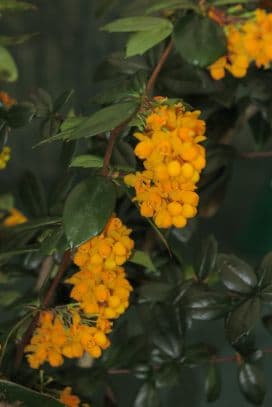
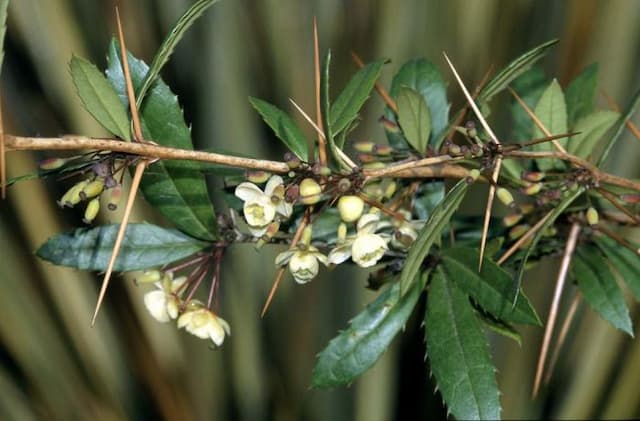
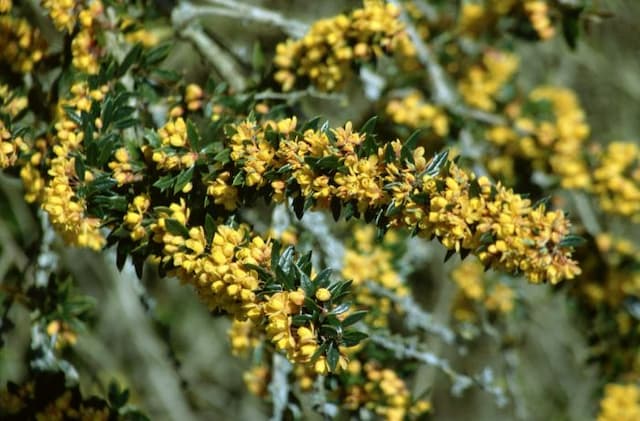
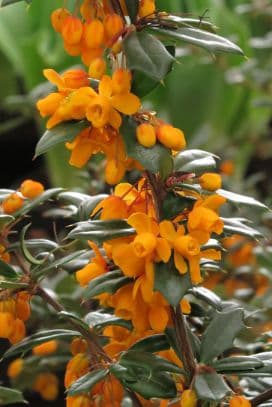
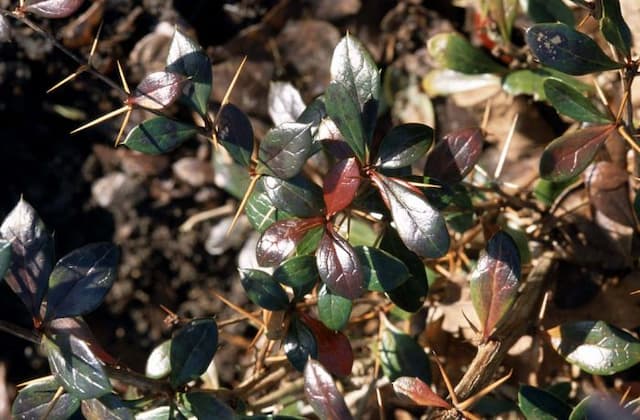


![Japanese barberry [Bonanza Gold]](/_next/image?url=https%3A%2F%2Fplants-admin.emdemapps.com%2Fimages%2Fplants%2F%2Fimages%2F604b5385e413f.png&w=640&q=75)

